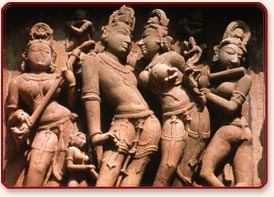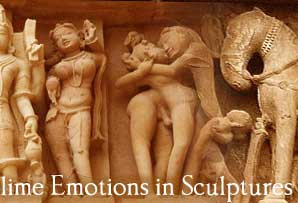 Temple town of Khajuraho is much different from any
other temple city of India. It is not about religion and worshipping and
deities. The temples of Khajuraho are instead famous for the eroticism
etched on its walls in the form of sculptures. An amalgamation of
science and art of architecture, these 10th-11th century temples have a
very interesting legend behind them that connects them to the origin of
Chandela dynasty. It is said that in a fit of passion and lust, the Moon
God seduced and ravaged a beautiful Brahmin girls known as Hemvati,
resulting in the birth of Chandravarman (the founder of the Chandela
dynasty). Later, Chandravarman had a dream where his mother requested
him to make a temple, which would reveal all aspects of the treasure of
passion and erotic fantasy to the world.
Temple town of Khajuraho is much different from any
other temple city of India. It is not about religion and worshipping and
deities. The temples of Khajuraho are instead famous for the eroticism
etched on its walls in the form of sculptures. An amalgamation of
science and art of architecture, these 10th-11th century temples have a
very interesting legend behind them that connects them to the origin of
Chandela dynasty. It is said that in a fit of passion and lust, the Moon
God seduced and ravaged a beautiful Brahmin girls known as Hemvati,
resulting in the birth of Chandravarman (the founder of the Chandela
dynasty). Later, Chandravarman had a dream where his mother requested
him to make a temple, which would reveal all aspects of the treasure of
passion and erotic fantasy to the world. Thus he brought an artistic revolution by building the famous Khajuraho temples, in the town, which was his capital. Some people also believe these erotic art forms to be the visual depiction of Kamasutra, art of sex or the relations between Shiva and Parvati, the divine couple. Khajuraho temples got lost into obscurity and were only discovered by chance but they quickly became India's second most favored tourist destination after Taj Mahal. This temple complex is perhaps the largest group of medieval temples. Other than eroticism, these sculptures also depict other refined courtly accomplishments such as music and dance. Only 22 temples have survived out of the original 85 temples. It displays one of the most unique stone-carving work and was declared a World Heritage Site in 1986.
Location: In Madhya Pradesh, India.
Significance:Well-known for the sculptures in erotic poses in its temples.
Climate:Khajuraho has extreme tropical climate with temperature as high as 47°C in summers and as low as 4°C in winters.
How to Reach:
By Air: Khajuraho has daily domestic flights to and from Agra, Varanasi and Kathmandu.
By Train:The nearest railway stations to Khajuraho are Mahoba, Satna and Jhansi. All of these are well connected to most of the major cities of India.
By Road:Khajuraho has frequent bus services and good roads to and from the major cities of India including Panna, Mahoba, Satna, Jabalpur, Bhopal, Gwalior, Indore, Agra and Jhansi.
Shopping Attractions:
The two distinctive group of temples of Khajuraho have dozens of souvenir stalls, hotels and restaurants at their entrances from where one can buy mementos and gifts for their loved ones back at home. Since it is the second most visited tourist destination in India (after Taj Mahal), it is not surprising to see signboards posted here in different languages as little boys efficient in number of languages peddling handicrafts and mineral water. It is even surprising to note how these little peddlers switch from Spanish to German to French, trying to sell a trinket to you almost forcibly.
Prime Attractions:
Temples of Khajuraho
It took more than 200 years to complete elaborately carved Khajuraho temples that are planned in a similar pattern. Built in the central Indian temple architectural style, the uninhibited and graceful erotic sculptures of Khajuraho temples are known for their paramount architectural balance and exquisiteness. The temple plans range from the simple ones to the most inspired ones. The lovely temples can be divided into three broad groups, namely, the Eastern group, the Southern group and the Western group. However, the Western group is not only the largest one but also the one, which is most easily accessible.
1. The Eastern Group takes in five isolated sub-group of temples situated in and around the present town of Khajuraho. Along with the three Brahmanical temples more commonly spoken of as temples of Brahma, Vamana and Javari, the three Jain temples of the deities Ghantai, Adinath and Parsvanath fall under this group.
2. The Southern Group is situated at the most distant location and includes mainly the two temples of Duladeo and Chaturbhuja, which are situated near and across the Khudarnala.
3. The Western Group is the largest of all the temple groups of Khajuraho. It is not compact and located in the center but also include the most renowned and noteworthy monuments built during the reign of the Chandela rulers. They are also known to have been maintained well by the Archaeological Survey of India and the lush green lawns surrounding them with multihued shrums and fragrant blossoms add to their beauty. The most prominent temples of the group are the Lakshmana Temple, the Matangesvara Temple and the Varaha Temple that are a part of a single complex, the Visvanatha and Nandi temples situated near the above-mentioned complex and the Chitragupta, Jagadambi and the Kandariya Mahadeo temples a little to the west of the complex.









